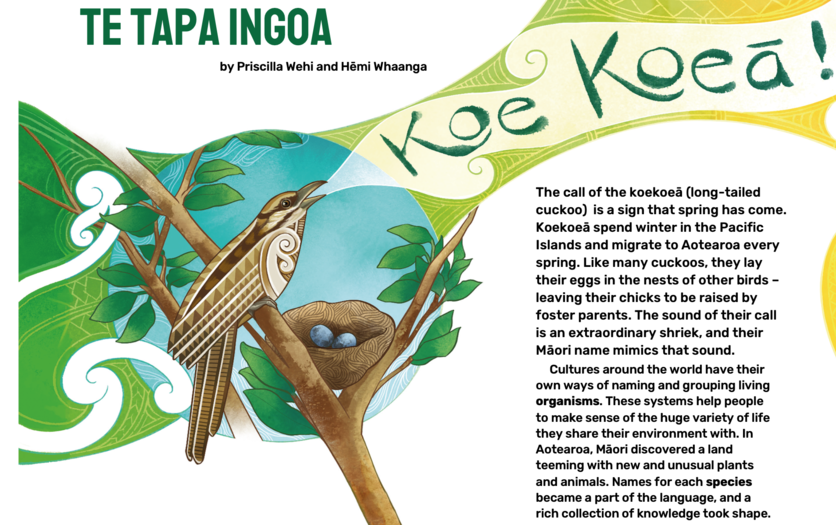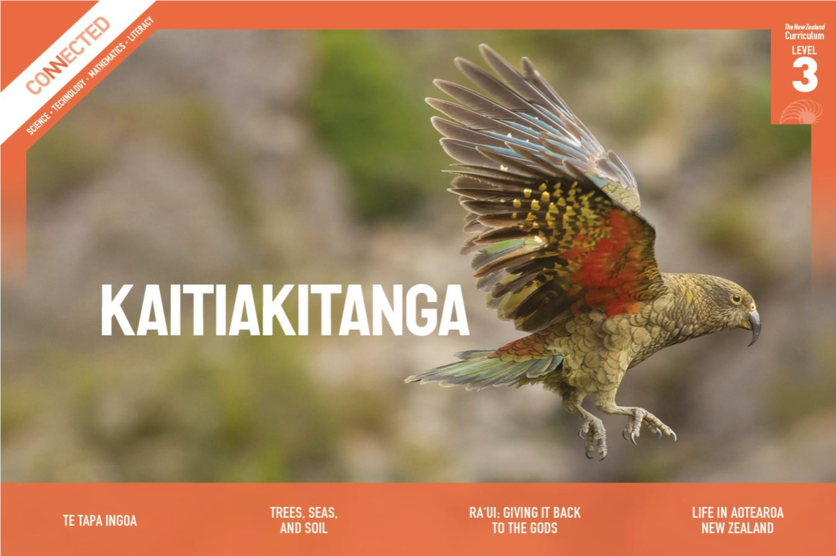This Connected article by Priscilla Wehi and Hemi Whaanga explores how early Māori named and grouped the plants and animals they found around them. Discover what this process reveals about Māori ways of viewing the world and the framework provided by whakapapa. It compares the Linnaean system for naming and grouping organisms and describes an example of Māori and Pākehā working together and drawing on knowledge from both systems.
The article provides many examples of how and why Māori choose plant and animal names, including a recently discovered species of beetle.
Check your school library for the article from the 2020 level 3 Connected journal ‘Kaitiakitanga’, download it as a Google slide presentation from Tāhūrangi or order it from the Ministry of Education.
The teacher support material (TSM) can be downloaded from Tāhūrangi (Word and PDF files available).
There are three learning activities that support the exploring technology aspects of the New Zealand Curriculum:
- The power of a name
- Learning from mātauranga Māori (this uses the Connected article Listening to the land, with the extension idea using Whakaotirangi and her kete of kūmara)
- Helping in the war on weeds (this links to the Connected article The war on weeds).
Mātauranga Māori and the nature of science
Whakapapa and scientific biological classification both involve systematic observations of living things to establish connections and make sense of the natural world. Whakapapa provides a framework of the living things and their connections in Aotearoa. Linnaean classification provides a global framework.
Related content
The article Māori knowledge of animals explores animal groupings using frameworks of whakapapa. It includes the Māori knowledge of animals interactive and has links to six articles that feature specific animal groupings. Watch the recorded webinar Animals of Aotearoa with Professor Georgina Tuari Stewart and Dr Sally Birdsall.
Explore ao Māori understanding of the concept of living and non-living here.
Find out more on naming species, classification systems and Taxonomy – the science of species discovery.
Watch these videos:
- Whakapapa and biodiversity – similarities between biodiversity and whakapapa from a Māori perspective.
- Plants and whakapapa – eco-sourcing from a Māori perspective.
- Ruru, restoration and whakapapa – why we need to consider the function of exotic trees during repo restoration.
The Ahi Pepe MothNet project looked at moths through a Māori lens – their whakapapa and their role in the ecosystem.
Using repo as a context for learning educators can include ideas from all strands and show their learners how science and te ao Māori are working together.
Project Mātauranga is a television series that investigates Māori world views and methodologies within the scientific community.
Want to incorporate mātauranga Māori in your teaching? See these two recorded PLD webinars Mātauranga Māori and Mātauranga and the Living World.
For an introduction to mātauranga Māori and science, read this article, and to discover many more resources, explore our mātauranga Māori topic.
Check out our entire range of Connected articles here. We’ve curated them by topic and concepts.
Connected articles
Read Whakaotirangi and her kete of kūmara to explore the important role of kūmara in te ao Māori.
Listening to the land looks at the work of a team of researchers who are collecting and recording mātauranga from iwi and hapū about plants and animals in Aotearoa.
Activity ideas
In Native plant leaves – DIY classification system, students get a taste of classification without having to work through the complexities of the Linnaean system. Alternatively they could use ferns, see DIY fern classification.
Develop a classification system is an activity where students work in small groups and come up with their own classification system for a number of marine organisms.
In Insect mihi students write a formal introduction for an insect species of their choice, including information about the insect’s relationship to other animals and also the land.
Useful links
Priscilla Wehi and Hemi Whaanga were two of the authors of this paper: The use of the Māori language in species nomenclature, Journal of Marine and Island Cultures, Vol 2, Issue 2, Dec 2013, Pages 78-84.
This Newsroom article, looks at what is the best way to go about incorporating te reo Māori in taxonomy. For more detailed information see the article Using te reo Māori and ta re Moriori in taxonomy, New Zealand Journal of Ecology (2019) 43(3): 3388.
Read this story from Te Ara – the Encyclopedia of New Zealand, The first naturalists: European discovery of plants and animals, it includes how in the Māori world view, all things were linked by genealogies (whakapapa).
In this Scientific America article Change Species Names to Honor Indigenous Peoples, Not Colonizers, Researchers Say New Zealand scientists make a case for updating long-held scientific names to incorporate more meaningful terms.
Pēpepe pōuri (sometimes known as pēpe pōuri) is the name for the indigenous forest ringlet butterfly. Find out how Jacqui Knight of the Moths and Butterflies of New Zealand Pūrerehua Aotearoa Trust discovered the connection between the pūrerehua and its name.
The Connected journals can be ordered from the Down the Back of the Chair website. Access to these resources is restricted to Ministry-approved education providers. To find out if you are eligible for a login or if you have forgotten your login details, contact their customer services team on 0800 660 662 or email orders@thechair.education.govt.nz.
Acknowledgement
The Connected series is published annually by the Ministry of Education, New Zealand.


